Mimi's best macaron recipe for making non-hollow macarons successfully. Perfect for beginner or professional use. Covering proper techniques: macaronage, aging the egg whites, making the meringue, figure-8 test, resting the shells and more.
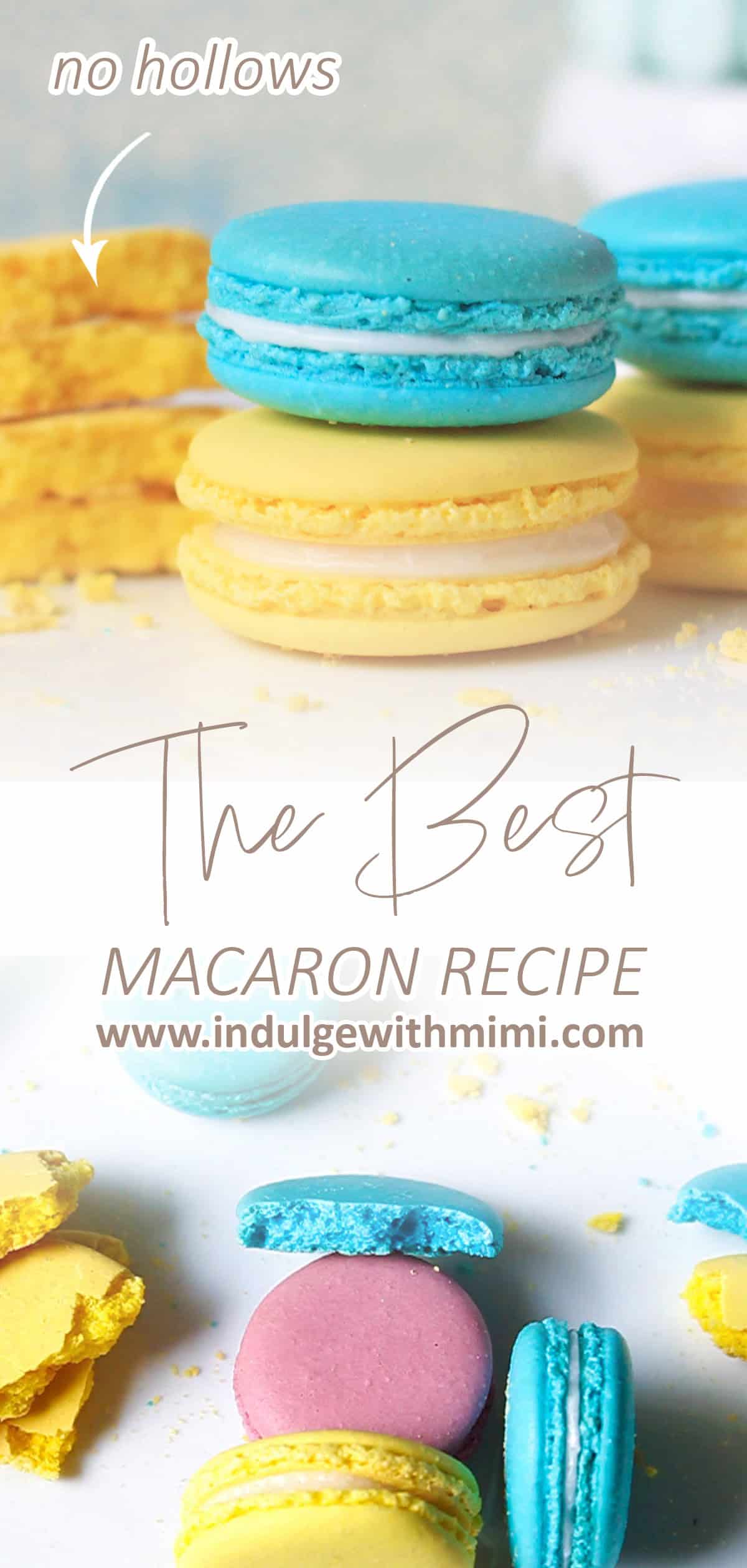
Jump to:
Why This Recipe Works
I'm happy to share this updated version of my best macaron recipe with you all. I first learned to make macarons from a French pastry chef and after a lot of trial and error and a lengthy recipe development process in my home kitchen, I created this user-friendly macaron recipe. It was originally published in 2014, since then countless home bakers have used it to successfully make macarons at home and professionally. Why it works:
- Ingredient ratios yield more consistent results, suited for bakers at every experience level.
- It covers all the foundation techniques you need.
- Tons of tips and video to help you nail down each step. Includes links to further in-depth articles.
- Free macaron template to help you pipe perfectly round macarons.
Remember, there isn't one magical recipe out there - including mine! What's important is that you learn the proper techniques and then tweak them with what works best in your kitchen and in your oven. Below I've included all the foundation techniques you will need. Start by following each step carefully and practice, practice, practice! Good luck my dears!
XOXO,
Mimi
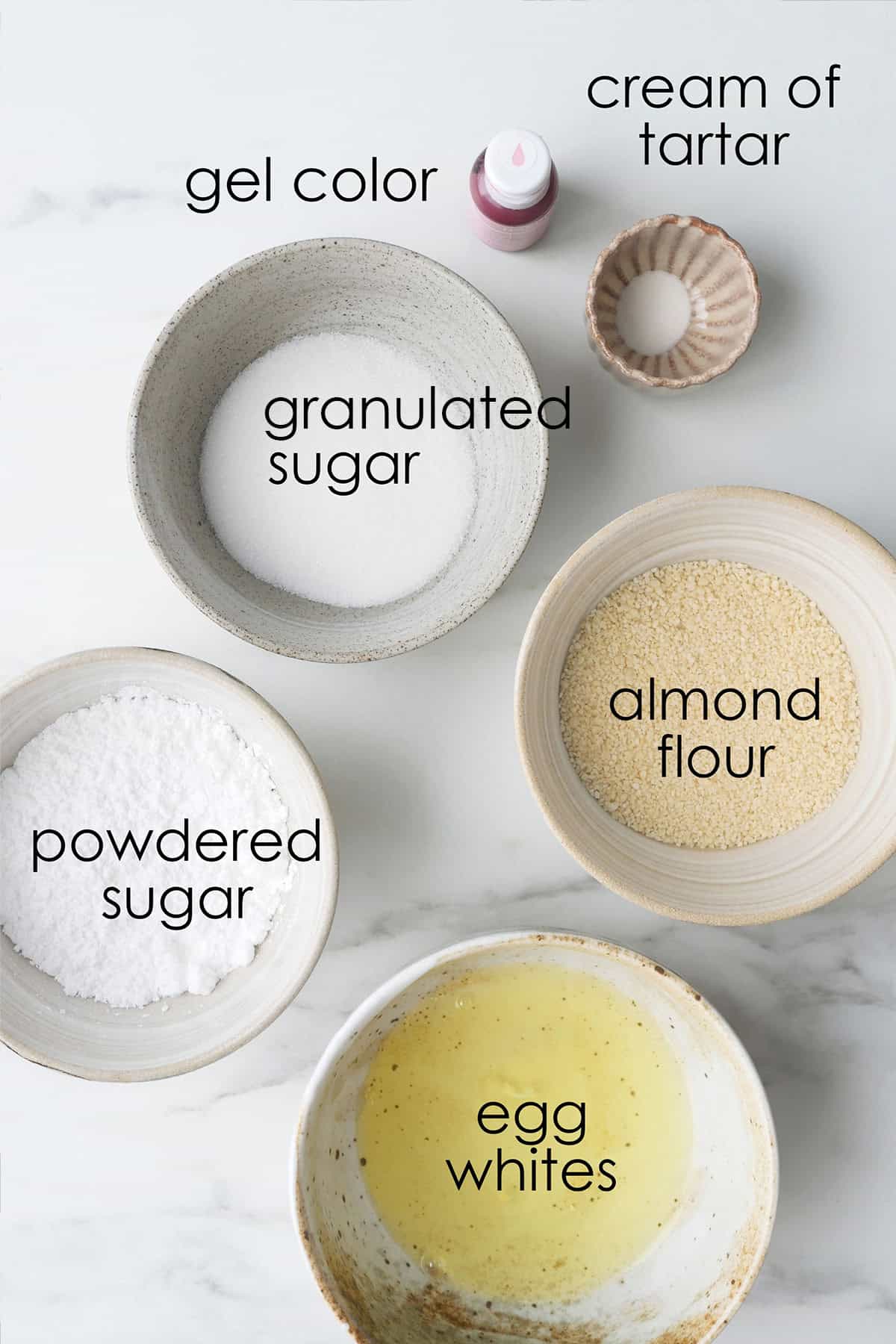
Ingredients & Substitutions
- Almond flour - it should be ground from blanched almonds. Some brands are more "oilier" than others so for the most consistent results, I like to make my own homemade almond flour. Alternatively, many readers have had good results with this brand.
- Powdered sugar - also known as icing sugar or confectioner's sugar. The type sold in North America usually contains a bit of corn starch as an anti-coagulant. It's important to always sift it for use in baking.
- Castor sugar - this is also known as extra fine granulated sugar or berry sugar. It's a finer granulated sugar that dissolves readily into the meringue making it ideal for macarons, which is heavily dependent on a strong and healthy meringue. If you can't find castor sugar, just use regular granulated sugar. Do not try to pulverize regular granulated sugar in the food processor to make castor sugar, it results in "chopped-up sugar crystals that will not perform well." (Source: chsugar.com)
- Egg whites, aged - egg whites that have been separated and let to "age" in the fridge have more relaxed proteins which makes it easier to whip to volume without overwhipping. It's recommended for the beginner macaron baker but is not absolutely necessary. Most carton egg whites are not intended for whipping into a meringue, check the back of the carton. A few (but not many) readers have reported success with carton egg whites.
- Cream of tartar - is an acid that is added to the meringue to make it more stable. It is usually found in the baking aisle next to the spices. If you do not have cream of tartar, you can substitute it with another acid like lemon juice or vinegar in double the amount. You can skip this ingredient if you can't find it. Make sure your bowls are clean and dry and whip carefully with room temperature aged egg whites until it reaches still peaks. If your egg whites take too long to whip or breaks apart, reconsider using cream of tartar.
- Gel food color - this is a more potent form of food color that doesn't add unwanted moisture into the macaron batter. Some brands perform better than others, I prefer this brand for its color stability, it doesn't fade after baking.

Best Macaron Baking Supplies
- If you don't have these tools yet, this post will show you how to make macarons without a mixer and fancy tools.
- Electric scale - Using a scale is a best way to measure ingredients accurately for baking as they can weigh differently depending on the way it is packed into a cup.
- Silicone mats - are excellent for keeping the piped batter in place for nice and round shells. They don't conduct heat as readily as parchment paper though and may require practice for the beginner.
- Parchment paper - is a good choice for beginners and can be repurposed for lining cake pans etc. Choose between using silicone mat or paper.
- Mixing bowls - should be non-porous ones in stainless steel or glass as plastic ones can trap oil which can prevent the proper formation of the meringue.
- Mixer - can be handheld or stand. At minimum, it should have slow and medium speeds. The egg whites in this recipe are in a small quantity but I have successfully made macarons using the Kitchenaid Pro stand mixer with the 5 QT bowl.
- Baking tray - preferably a rimless one to allow for even air flow. I prefer the one I linked here because it conducts and maintains heat without warping.
- Spatula - use a flexible one, the bigger the better when folding meringue. It will prevent excessive folding causing lost of air in the batter. I use the L size in the set.
- Sieve or strainer - used to aerate the dry mixture and isolate large almond bits for the smoothest macaron shells.
- Piping bag - use them instead of Ziplock bags. The linked piping bags are thick and sturdy. They won't bend and shuffle around as you hold it, helps in piping rounder shells.
- Oven thermometer - consistent temperature and sufficient heat is essential for baking full macaron shells without hollows. A thermometer will help you assess when the oven is fully pre-heated and ready for baking.
- Round piping tips - help pipe nice and round macaron shells. I prefer using the smaller tips for fuller shells without hollows e.g. Wilton round #10 or round #12.
- Macaron template - is helpful for piping even sized shells that are evenly spaced for baking. You can get access to all my free macaron templates after you sign up for my newsletter.
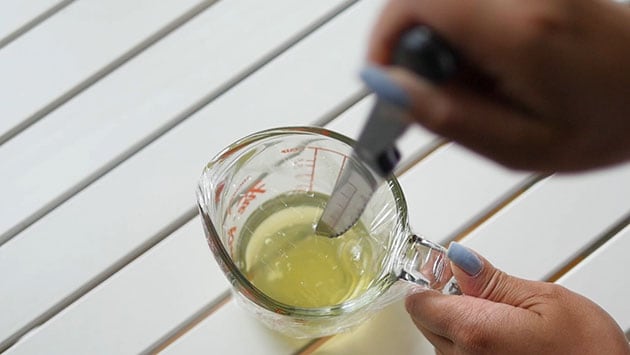
Prep Work & Tips for Success
- Wipe down mixing bowls with some vinegar to remove leftover oils. Then use bowls to store egg white for "aging". The meringue does not whip well in the presence of oil.
- Age the egg whites 24 hours in advance. Separate the egg whites with an egg separator while the egg is still cold, making sure that no traces of egg yolks remain. Wrap with plastic wrap and poke a few holes into it. Place it in the fridge to rest until ready to use READ: Detailed instructions on how to age egg whites.
- About 30 minutes before baking, bring the egg whites back to room temperature. To speed up the process, soak the vessel holding the egg whites in warm water. Be very careful not to let any water get into the bowl.
- If your parchment paper comes on a roll, flatten it out by laying heaving objects on top. Piping the batter on a smooth flat surface will prevent it from spreading into odd shapes.
- For the most accurate measurement, measure all the ingredients with a kitchen scale.
- Set up piping bag by pushing the piping tip firmly into the opening. This ensures that it doesn't move around when you start piping. Twist the bag and push it into the piping tip to stop any macaron batter from leaking out when you begin to fill it. Set this bag inside a tall glass. Open up the top so that you can have both hands free to fill up the bag later. WATCH VIDEO: How to Set up Piping Bag for Macaron Batter
- If you live in a moist humid environment and have a dehumidifier, set it to bring the humidity level in the room below 50. This is the dehumidifier I have. I turn it on in the kitchen after washing dishes or cooking a dish that releases steam into the kitchen. Alternatively, if the kitchen is humid after water use, open the windows and turn on the range hood fan. A dryer environment will help the macaron shells to "rest" and develop a skin after piping.
Macaron Templates
Generally, the most popular size for round macarons is 1.5". However, you can definitely pipe the shells larger or smaller. Pipe the batter using a template as your guide so you can have similarly sized shells for matching during assembly. You can download free macaron templates in other sizes like 1.25", 1.5", 1.75" by subscribing to my newsletter.
Step By Step
Step 1: Prep Almond Flour and Powder Sugar
Sift together the almond flour and powdered sugar to eliminate big pieces and aerate the mixture. Optional: run the combined mixture through a food processor to further break down the bigger pieces first.
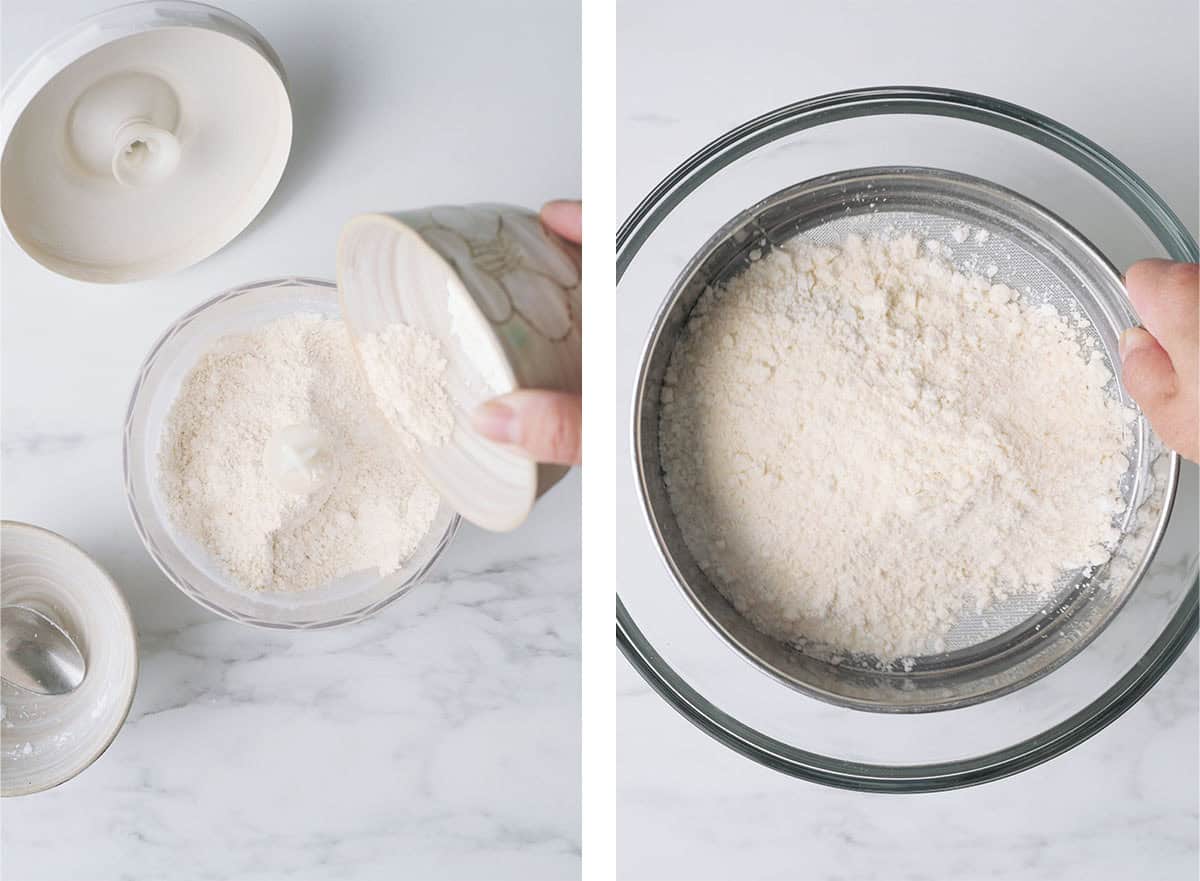
Step 2: Whip Egg Whites & Add Acid
In a separate bowl with a handheld or counter top mixer, whip egg whites on slow-speed until foamy, then add cream of tartar. The cream of tartar is an acid that aids in stabilizing the meringue, it can be replaced with another acid (e.g. lemon juice or vinegar) in double the amount.
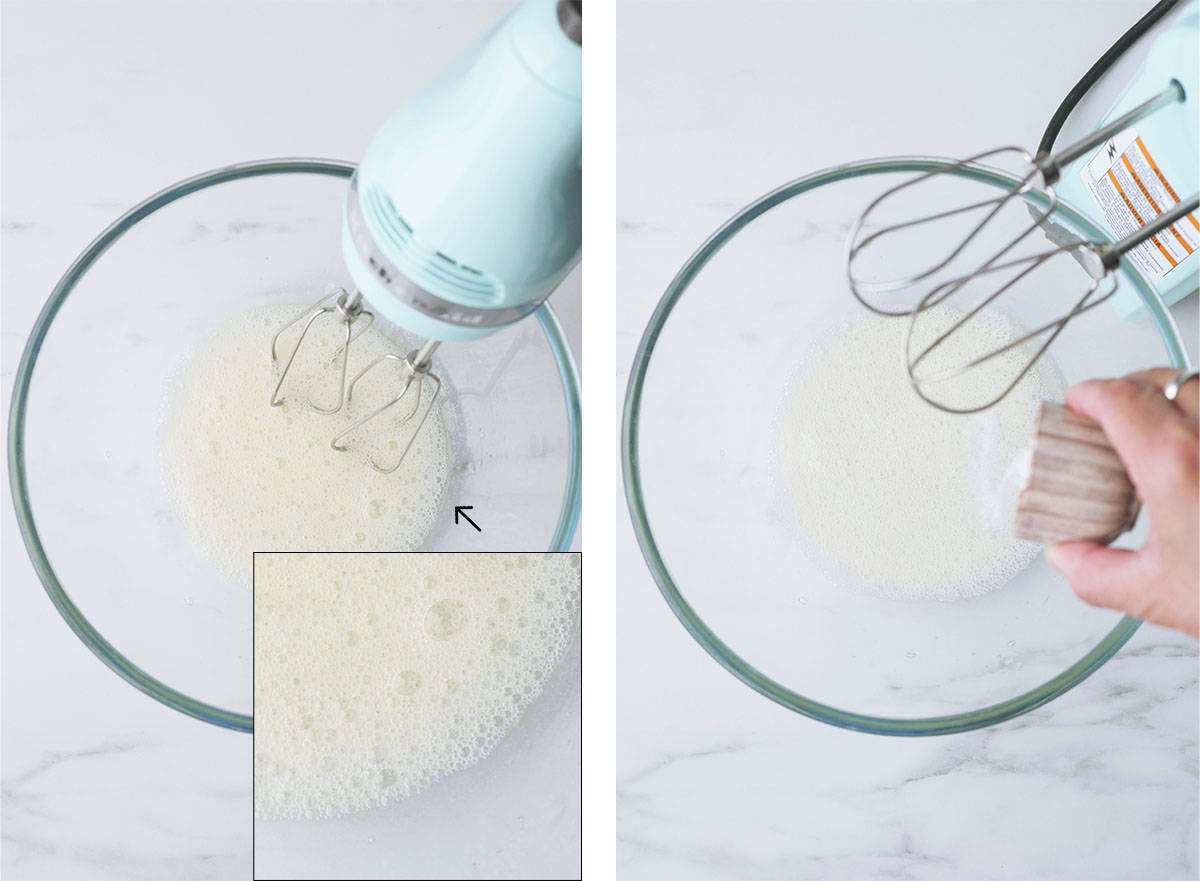
Step 3: Add Sugar to Egg Whites
Once the beaters start leaving tracks inside the egg whites and the foam bubbles have reduced in size, add granulated sugar ⅓ at a time while continuing to whip. Increase speed to medium.

Step 4: Add Gel Color at Soft Peaks
Once all the sugar has been fully incorporated and the meringue is at soft peaks stage add 1-3 drops of gel color to your liking. This stage is characterized by soft points that fall back onto itself when the beaters are pulled out.
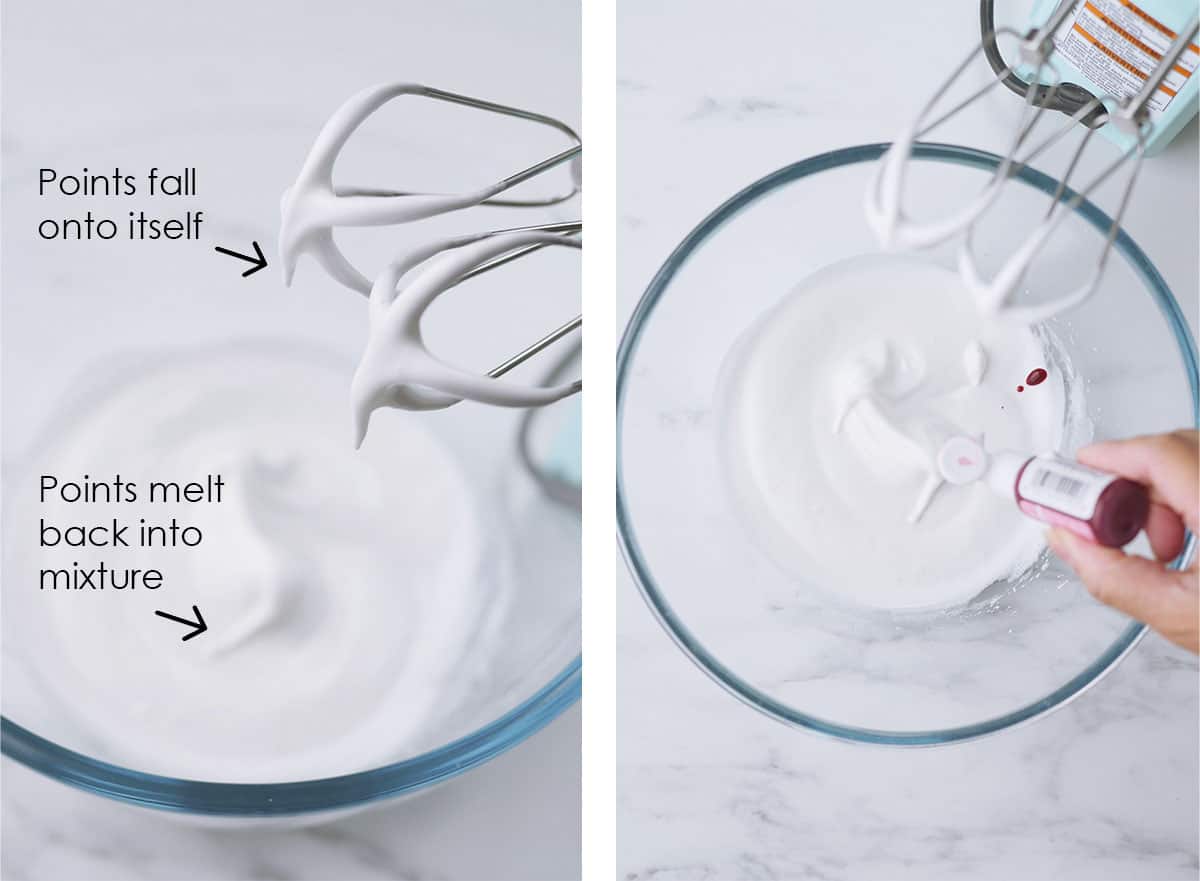
Step 5: Whip Until Stiff Peaks
Whip until stiff peaks. This stage is characterized by points in the meringue that point upwards when the beaters are pulled out. Test the meringue by flipping your bowl COMPLETELY upside down. The whites should not slip or fall, instead it stays firm inside the bowl. WATCH VIDEO: How to Make Perfect Meringue for Macarons
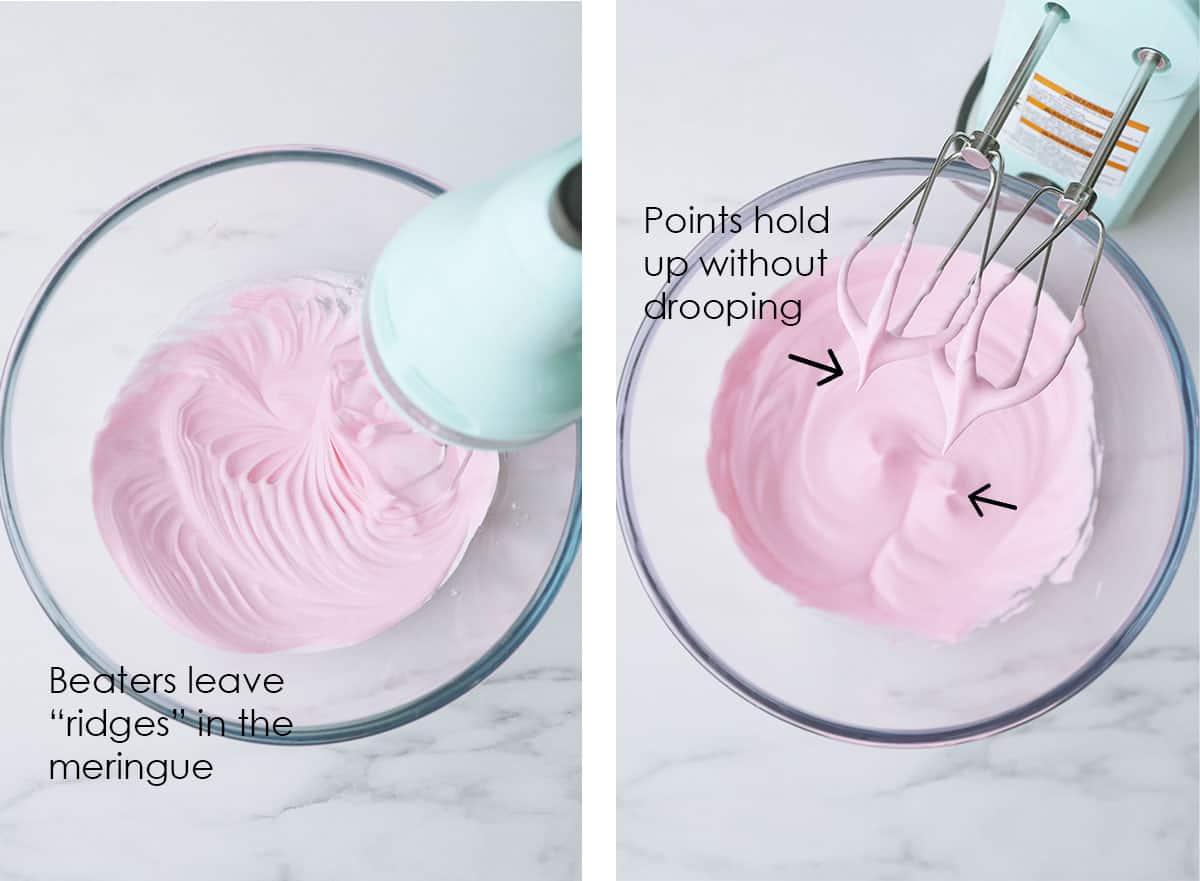
Step 6: Macaronage or Folding
Pour ⅓ of the almond mixture into the egg whites. Gently fold this dry ingredient into the egg whites, then add the rest of the dry ingredients ⅓ at a time. Do not mix or stir. Folding properly will ensure that the air bubbles that you beat into your egg whites do not all deflate when incorporated with the heavier dry ingredients.
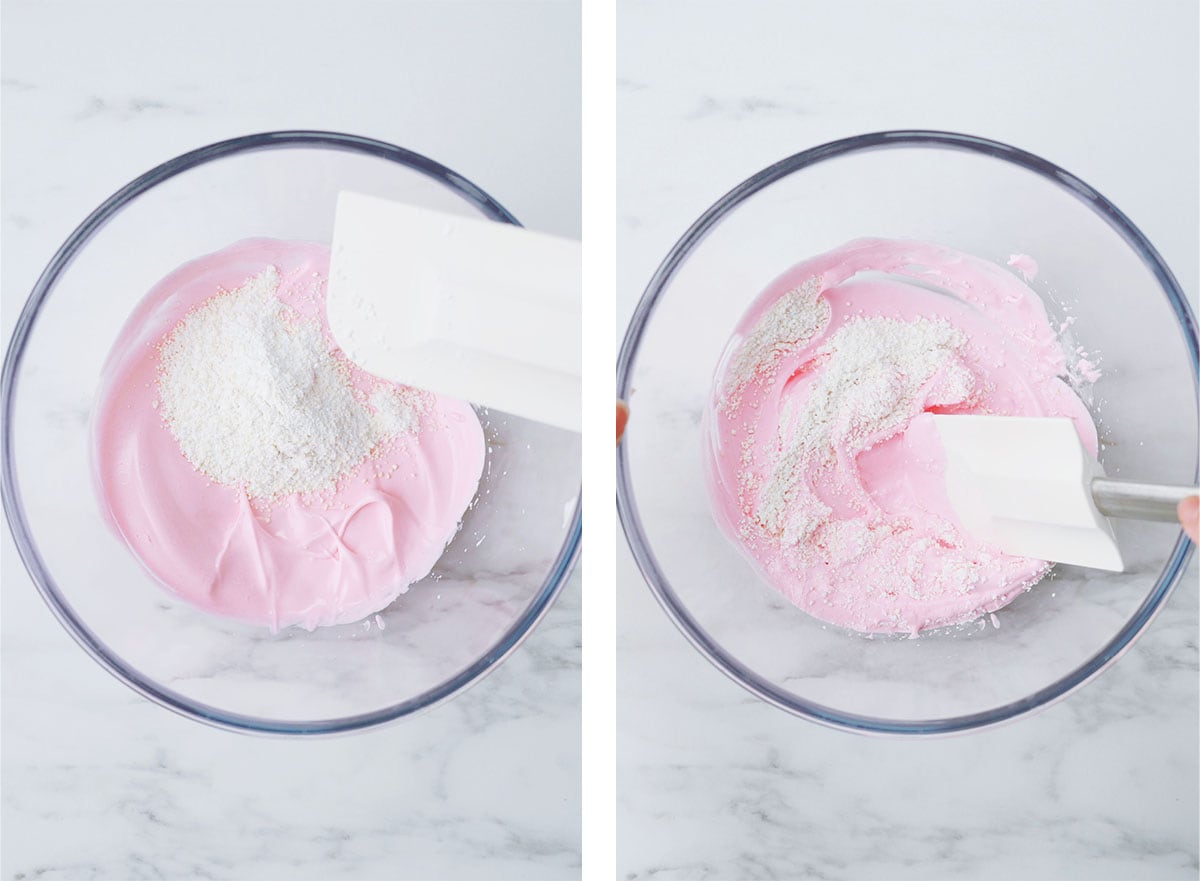
How to Fold Macaron Batter
This is a very critical step in the macaron making process called "macaronage". Take the spatula and gently go under the mixture, use a sweep down-across-up-and-over motion (like you're scraping around the bowl towards the middle) while turning the bowl at the same time. Occasionally, cut down through the center of the mixture to incorporate the ingredients in the center. Do not "dump" the mixture back into itself. If you fold gently, it will eventually incorporate into one mixture even though it may not look like it will at first.
Step 7: Stop Folding & Check Batter Consistency
Stop folding once the batter has reached a honey-like consistency. To check the consistency, occasionally, pick up the batter and see how it runs. You should be able to write a "figure-8" pattern with it, stop folding immediately once it reaches this point. The success of your macarons will depend largely on your ability to gauge when to stop folding your batter. WATCH VIDEO: How to Fold Macaron Batter Shown in Real Time
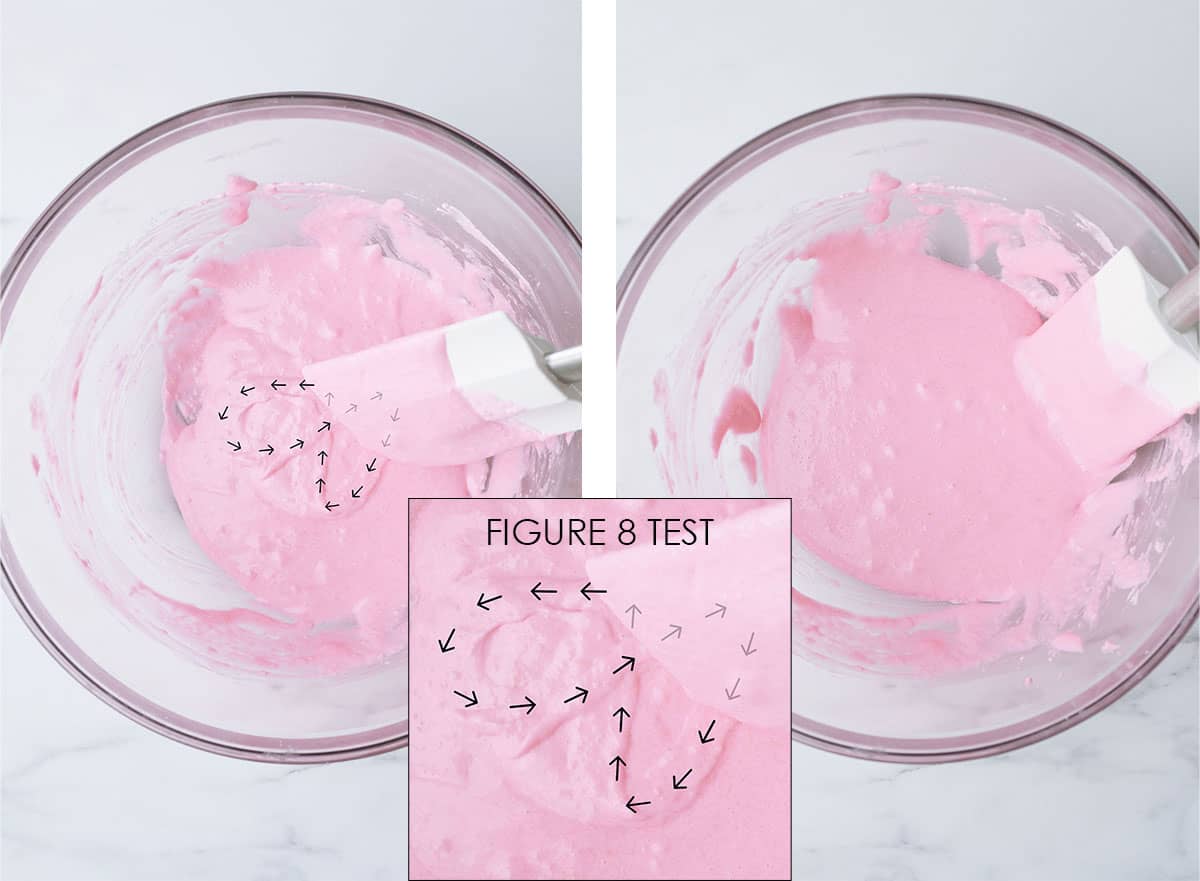
How Long Should I Fold the Macaron Batter?
As soon as the batter begins to look homogenous, start testing the consistency. With your spatula, pick up the batter and drop it back into the bowl. It should not "plop" down into the bowl but flow very slowly like honey. It should fold into itself just a few times like a ribbon but no more than that. Pick up the batter and let it flow down while drawing the figure "8". If it can do that, immediately stop folding. If it looks like a runny pancake batter, then you've gone too far! Watch my YouTube video as a visual guide.
It's always better to under mix than to over mix. When you under mix, your macaron shells will still form albeit, they'll be bumpy. But if you over mix, you will deflate the air in your egg whites and your macaron shells will spread like crazy when you try to pipe it.
Step 8: Piping
If using parchment paper, dab a little bit of batter on the bottom of all four corners of the parchment paper. Use it as a "glue" to keep the paper attached to the tray while piping. Gently transfer the batter into the piping bag with a spatula.
To pipe, start from the center while holding the piping bag vertically and squeeze while applying even pressure to all sides until the batter has nearly reached the size of the template, swing the tip around back towards the center and pull away, that's where you want your batter to end. Ideally, if your batter has been prepared properly and is at the correct consistency, the "points" should sink back into itself.
Tip: remember to squeeze out the batter from the top of the bag without handling it excessively since you don't want the structure of the batter near the end to be compromised. Here's a post showing you the proper consistency of a macaron batter after piping.
Step 9: Rap & Remove Bubbles
Remove the paper template from underneath the parchment paper. Rap the tray several times on the counter to allow any air bubbles to escape and prevents your macarons from cracking during the baking process. If the points do not smooth out after rapping, then the batter is too thick. Next time, try to fold the batter just a bit more before piping. Before the batter dries, pop any remaining bubbles with a toothpick.
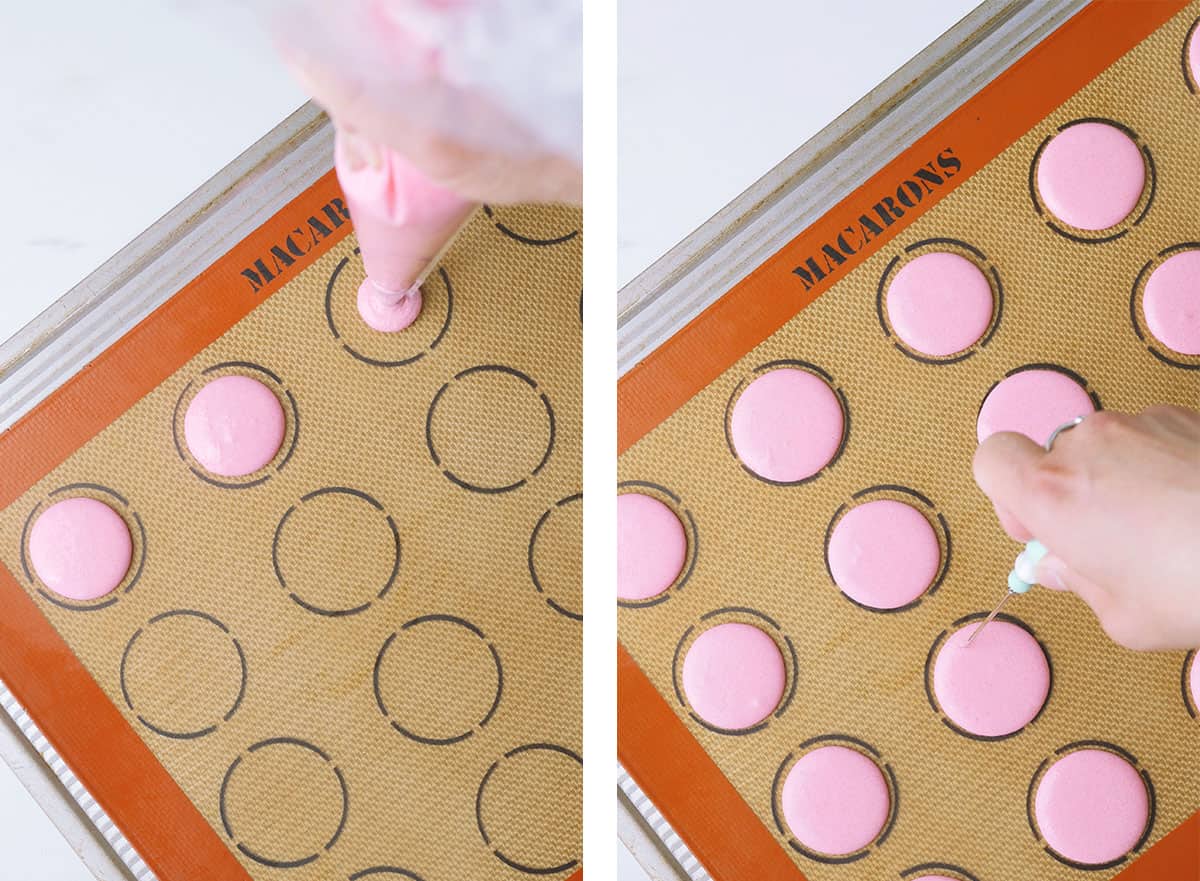
Step 10: Resting
Let it rest on the counter for 30 min. AND until a "skin" has developed. Once the shell looks dull and matte as opposed to glossy like when it was first piped, test on a sacrificial shell. Lightly touch the surface of the shell and if no batter sticks to your fingers, it's ready.
Do I Need to Rest the Macaron Shells?
Resting the shells can help aid in developing a firm skin that prevents it from cracking in the oven during baking. Sometimes the shells can be rested for 30 minutes or more and a skin may still not develop due to a humid environment OR if the batter is weak. The timing is not as important as the presence of a skin and a matte dull finish. You DON'T have to rest the shells but it is extra insurance for those who are new to macaron baking. Click here for a full post on this topic.
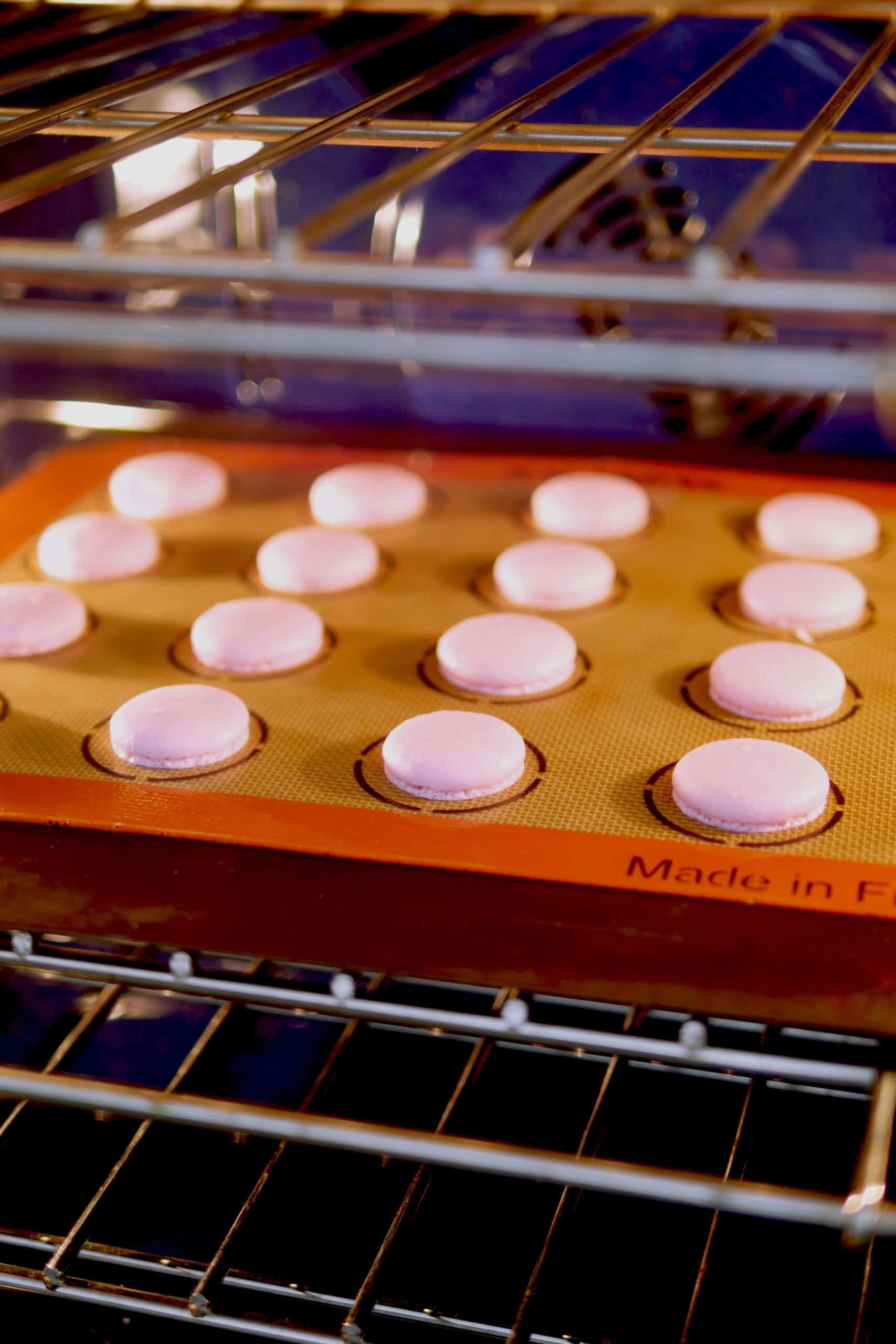
Step 11: Baking
Preheat your oven to 320 F. Place an external oven thermometer inside the oven to ensure that the temperature is correct. Many bakers assume that their ovens are at the correct temperature when in fact the temperature has increased or decreased during the baking process without their knowledge. A steady and consistent temperature is needed for macarons to bake without deflating, resulting in hollow macarons. READ: how to prevent hollow macarons.
Place the tray on the middle shelf and bake for 12-14 minutes. Bake only one tray at a time. Every oven is different so I suggest using this temperature and rack position as a baseline if it's your first time making macarons, then make any adjustments you need to perfect them.
Click here to read about the different ways to set your oven for baking perfect macarons.
Click here to read about how to control the oven temperature for baking macarons.
Step 12: Check Doneness
Take the shells out to test doneness. Use a spatula to lightly tap the feet, it should be firm and not push back. Wiggle the top of the shell from left to right, it should not be wobbly. Lightly peel back the parchment paper and the macaron should peel off easily without sticking (This does not work well on silicone mats though.) If it doesn't pass the tests above, put them back in the oven and bake an extra 1 minute at a time.
Keep on pan to cool off or take them off. If the bottoms are just a tiny bit sticky (just a little bit though), keep them on the tray to cool off for about 15 min. If however, the bottoms are already brown, they peel off cleanly or appear over-baked, take them off the hot tray to cool down. Break one open and check the inside, it should be fully set and not overly moist. If it is too moist the cookies will collapse when they cool. Err on the side of over baking rather than under baking as the maturation process will be able to salvage over baked macarons.
Step 13: Fill and Assemble
Fill with your favorite filling. Place the filling in a pastry bag and squeeze a dollop of it in the center. Stop a few millimeters before reaching the edge so it won't overflow once it's assembled with the other shell. Click here to get some yummy filling ideas.
Step 14: Maturation
Leave them in the fridge in an airtight container and let them mature for 24 hours. Once matured, the flavors will be absorbed into the shell. If your shell is hard/crunchy/over baked, the maturation process allows the shells to absorb the moisture from the filling resulting in that distinctive soft and chewy texture. The maturation process can also be sped up by lightly brushing the bottom of the shells with milk or a syrup that is the same flavor as the filling. 30 minutes before serving, bring them back to room temperature. ENJOY!
How to Store and Freeze Macarons
Macarons should be stored in the fridge in an air-tight container. The shells by itself will stay fresh for 4-6 days while assembled macarons will stay fresh for 2-4 days, depending on the type of filling used. If you're making them in advance and want to extend the shelf life, you can either assemble them closer to the serving date or freeze them. The shells alone or fully assembled can stay frozen for up to one month without affecting the freshness or quality. Take a look at this dedicated post on How to Store and Freeze Macarons for ideas on what types of fillings freeze well and further details on this topic.
FAQ
It all comes down the the preparation of the meringue. In the French method, the meringue is made by pouring sugar into egg whites that are being whipped, creating a French meringue. In the Italian method, sugar is heated with water to create a hot syrup first and then simultaneously poured into egg whites that are being beaten. If you have no previous experience making an Italian meringue for other pastries, this French macaron method is the easier one to start with. However, both would yield the same type of magical chewy and flavorful cookies that most people would know to be a macaron. (Click here to read more about the textural differences between a French and Italian macaron).
The pronunciation between macaron and macaroon is quite different as well. The 'on' in macaron is pronounced more like 'aw' as in lawn. Whereas, macaroon is pronounced exactly as it's written, the 'oon' is pronounced the same as in the word moon.
A macaron and macaroon are two totally different pastries. Because of the similar spelling, the two have been mistakenly used interchangeably in the last few years. A macaron is a French pastry that is composed of 2 airy meringue cookies containing egg whites and almonds, and then sandwiched with a softer flavored filling in between. Macaron cookies come in a variety of colors and shapes. A macaroon, on the other hand, is usually made with shredded coconut, sugar, flour and egg whites. It's simply mixed together and formed into a ball for baking. It looks more like a melted snowball.
Yes and no. First of all, I should make clear that there is absolutely nothing special about a recipe that says no resting is required. It is simply the author telling you not to do so. They are not guaranteeing that your macarons will not crack in the oven. This part is all up to you. I have a whole post on whether resting the macaron shell is necessary. If your batter is prepared correctly, it can go right into the oven without resting. Resting the macaron shell is great for those times when the batter is a bit thin and needs some time to develop a skin so it doesn't crack in the oven.
No, you can bake them just as easily on parchment paper. Silicone mats are better for keeping the shapes perfectly round, however, they are a bit trickier to use because they don't conduct heat as well. I prefer using the official Silpat brand silicone mat because it is made with food grade silicone and conducts heat well.
Common Problems and Troubleshooting
Cracked Macarons
Cracked macarons are caused by trapped excess air in the batter, using too high heat or a weak meringue. Tips: Rap the tray after piping to release all the excess air out of the batter, find an optimal oven temperature that is not too hot but still allows the macarons to develop. Make sure meringue has reached stiff peaks.
Macarons With No Feet
Macarons without feet are caused by a weak meringue and low baking temperature. Tips: Whip the meringue to stiff peaks and make sure to rest the macaron batter after piping. After that, use a higher temperature to assist the rise in the oven during baking. Increase the temperature by 25 degree intervals.
Lopsided Shells
Lopsided macaron shells can be caused by problems in the batter, oven conditions, baking tools, resting time or piping techniques. Tips: Deflate a sufficient amount of air from the batter by using proper folding techniques until the batter reaches the figure-8 stage; turn off convection fans inside the oven if it's too strong; use sturdy flat baking trays that don't buckle; watch out that the shells are not overly dry after resting; and pipe the batter while holding the bag completely vertically. More problems and troubleshooting in this dedicated post below:
Readers Share Their Success Stories
So how did yours turn out? I hope you enjoyed the process and the recipe worked out well for you. If you didn't quite achieve the results you're looking for this time, try using some of the tips I've provided in my macaron troubleshooting guide and other macaron technique posts I've written below.
And don't forget to share all your beautiful babies with me on Instagram and Facebook. I love sharing everyone's results here. Let's talk baking! Until next time.
XOXO, Mimi
Note: This post was originally published on September 27th, 2014.
Recipe
Best Macaron Recipe by Mimi
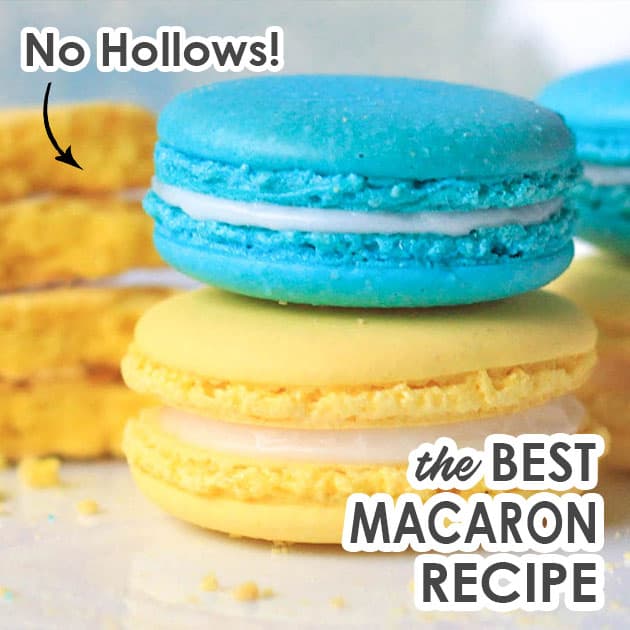
Mimi's best macaron recipe for making non-hollow macarons successfully. Perfect for beginner or professional use.
Ingredients
Macaron Ingredients
- 65 grams almond flour*
- 65 grams powdered sugar
- 45 grams castor sugar (a.k.a “berry” sugar or extra fine granulated sugar)*
- 50 grams egg whites, aged, room temperature*
- ⅛ teaspoon cream of tartar
- GEL color of your choice*
Supplies
- Electronic scale
- 2 very clean and dry mixing bowls
- Hand mixer
- Sifter
- Flexible spatula
- Piping bag
- Round piping tip*
- Good quality baking pan
- Template with macaron outline
- Oven thermometer
- Parchment paper or silicone mat
Instructions
Notes
- This recipe yields 12 assembled macarons. This recipe can be doubled, tripled, and so forth.
- Read this post on How to Make Your Own Almond Flour
- Regular granulated sugar can be used but castor sugar is preferable.
- Measure out 50 grams of fresh egg whites and then age it before using. Do NOT use meringue powder
- Use GEL food color, do not use liquid color.
- Recommended round piping tips: Wilton #12 or Wilton #1A. I prefer Wilton #1A or Ateco #805 Plain Seamless Tip for regular round macarons or Wilton #12 for more control with character macarons.
- To further shelf life, unfilled macaron shells and assembled macarons can be frozen for up to one month.
- Free macaron templates can be downloaded from my Member's Only Area. Sign up for the newsletter to receive the password to enter.
Recommended Products
As an Amazon Associate and member of other affiliate programs, I earn from qualifying purchases.
-
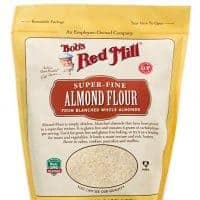 Bob's Red Mill Super-Fine Gluten Free Almond Flour, 3 Pound
Bob's Red Mill Super-Fine Gluten Free Almond Flour, 3 Pound -
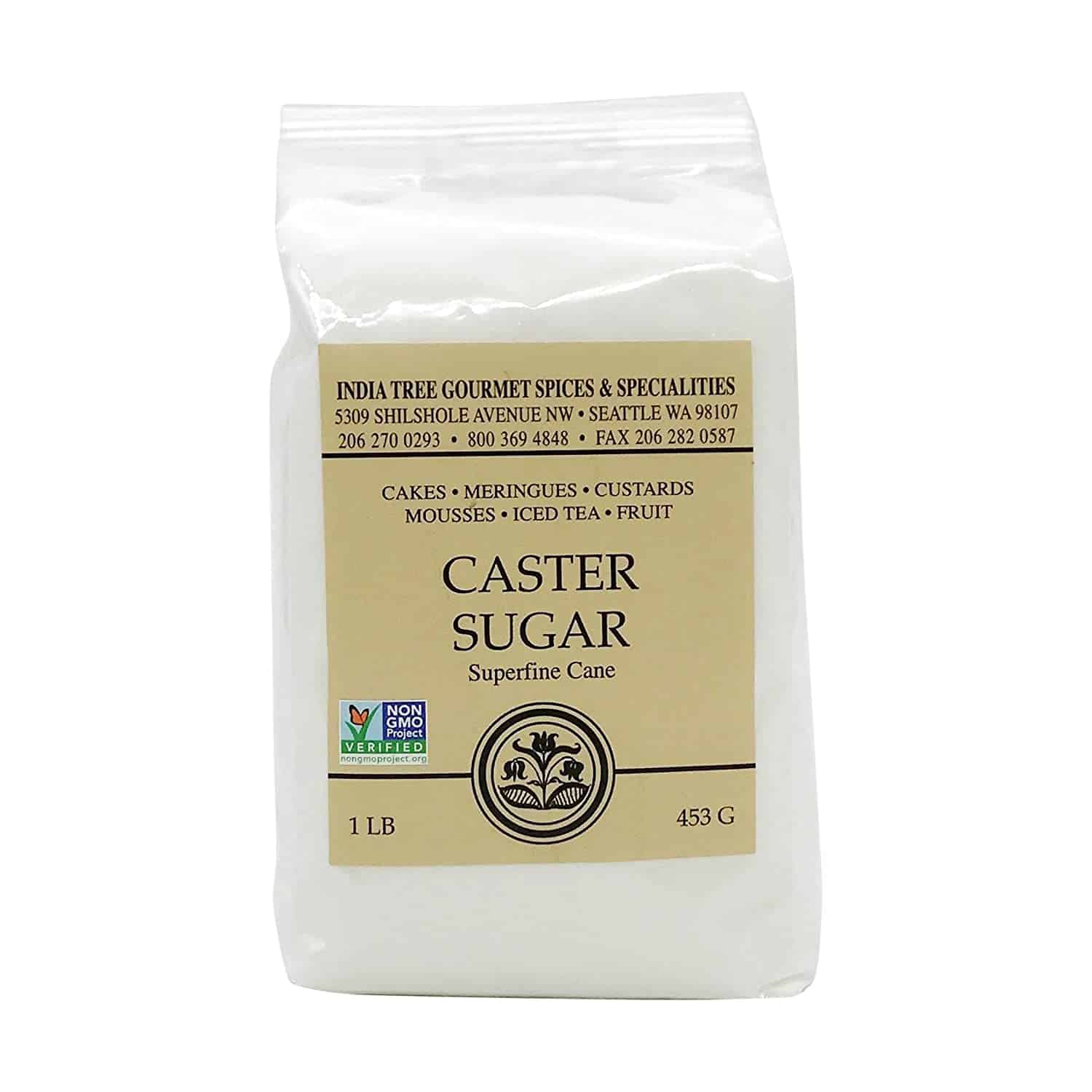 India Tree Superfine Caster Baking Sugar, 1 lb. bag
India Tree Superfine Caster Baking Sugar, 1 lb. bag -
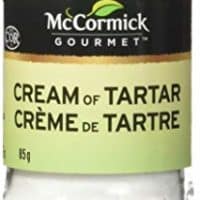 McCormick Gourmet All Natural Cream Of Tartar, 2.62 oz
McCormick Gourmet All Natural Cream Of Tartar, 2.62 oz -
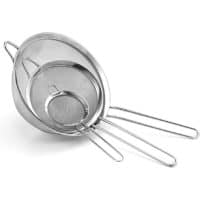 Cuisinart CTG-00-3MS Set of 3 Fine Mesh Stainless Steel Strainers
Cuisinart CTG-00-3MS Set of 3 Fine Mesh Stainless Steel Strainers -
 Round Piping Tip #10
Round Piping Tip #10 -
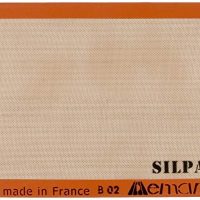 Regular Sized Silpat Non-Stick Silicone Baking Mat
Regular Sized Silpat Non-Stick Silicone Baking Mat -
 Cuisinart CTG-00-SMB Stainless Steel Mixing Bowls with Lids, Set of 3
Cuisinart CTG-00-SMB Stainless Steel Mixing Bowls with Lids, Set of 3 -
 Toaster Oven Size Silpat Non-stick Silicone Baking Mat
Toaster Oven Size Silpat Non-stick Silicone Baking Mat -
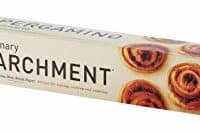 PaperChef Culinary Parchment Multipurpose Non-Stick Paper, 205 sq ft
PaperChef Culinary Parchment Multipurpose Non-Stick Paper, 205 sq ft -
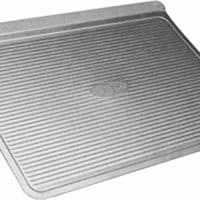 USA Pan Rimless Baking Sheet for Better Airflow to Macaron Shells
USA Pan Rimless Baking Sheet for Better Airflow to Macaron Shells -
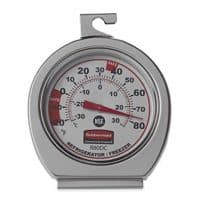 Oven Thermometer
Oven Thermometer -
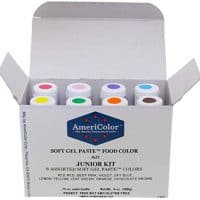 Gel Food Coloring AmeriColor Junior Kit, 8 Colors.75 Ounce Bottles
Gel Food Coloring AmeriColor Junior Kit, 8 Colors.75 Ounce Bottles -
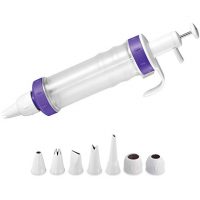 Batter Piping Tool
Batter Piping Tool -
 Ateco Disposable Piping Bags, 12-Inch, Pack of 100
Ateco Disposable Piping Bags, 12-Inch, Pack of 100 -
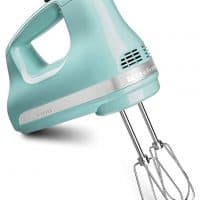 Kitchenaid Handheld Mixer
Kitchenaid Handheld Mixer -
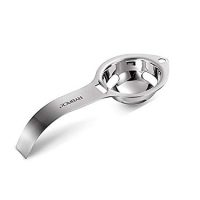 RYBACK Stainless Steel Egg White Yolk Filter Separator Cooking Tool Dishwasher Safe Chef Kitchen Gadget
RYBACK Stainless Steel Egg White Yolk Filter Separator Cooking Tool Dishwasher Safe Chef Kitchen Gadget -
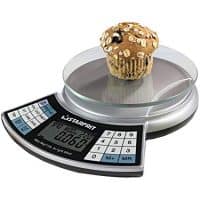 Digital Scale
Digital Scale
Nutrition Information
Yield
12Serving Size
1Amount Per Serving Calories 73Total Fat 3gSaturated Fat 0gTrans Fat 0gUnsaturated Fat 2gCholesterol 0mgSodium 9mgCarbohydrates 11gFiber 1gSugar 10gProtein 2g
This information is provided as a courtesy and is an estimate only. This information comes from online calculators. Although indulgewithmimi.com attempts to provide accurate nutritional information, these figures are only estimates.


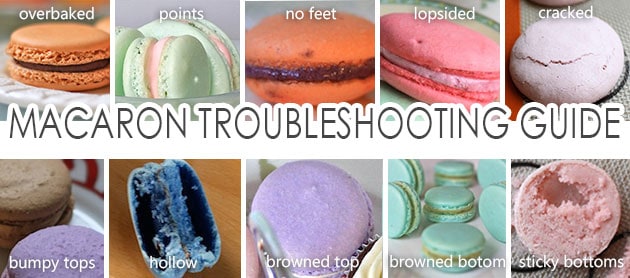
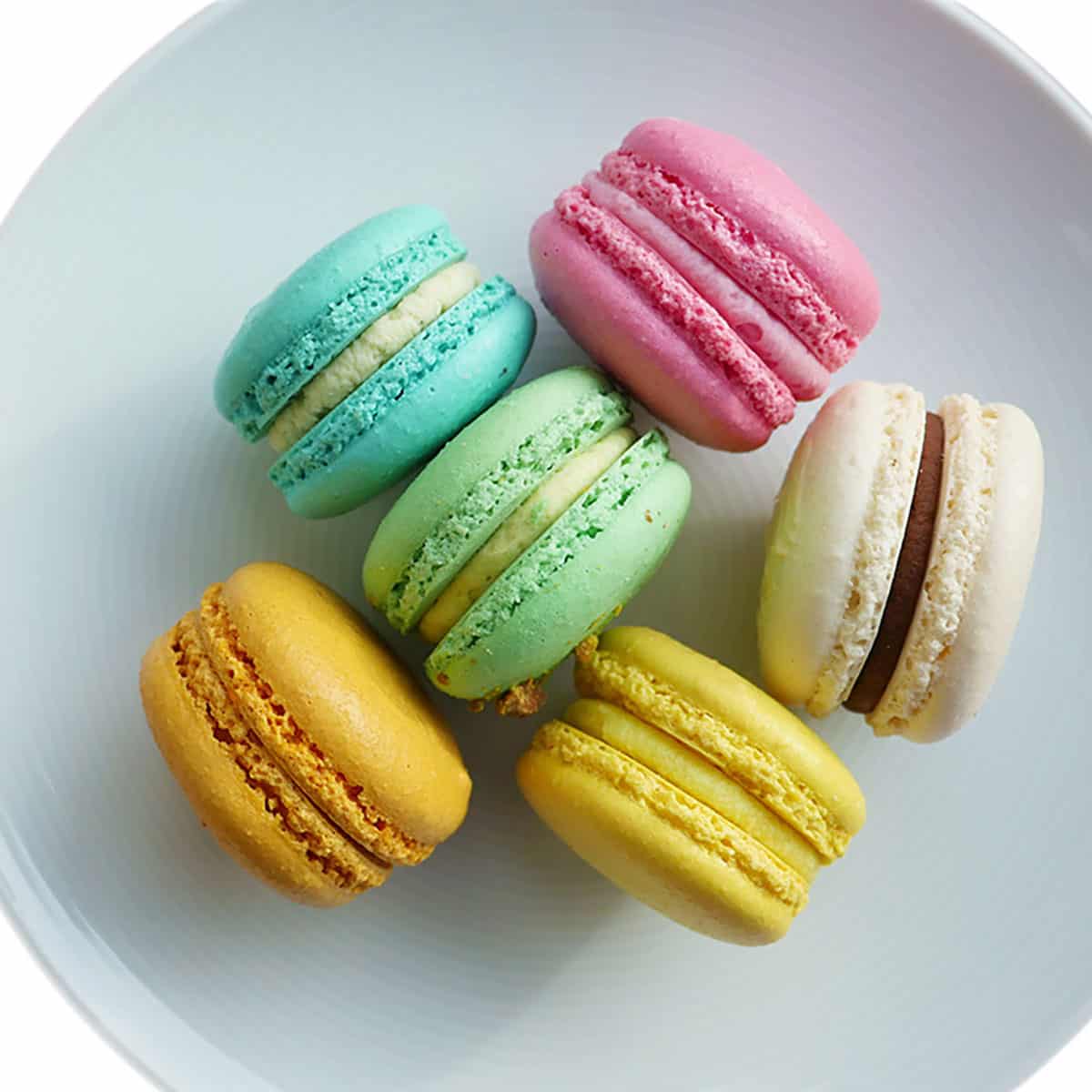
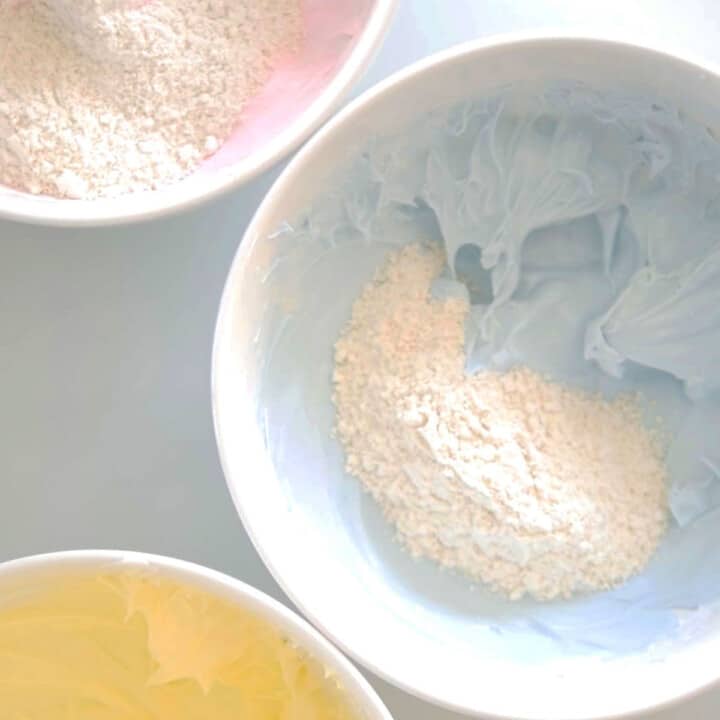

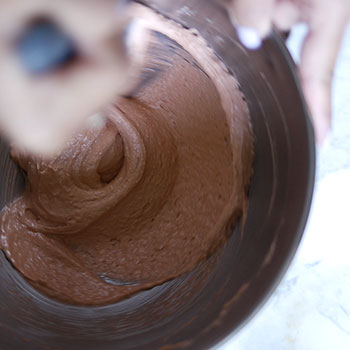
pav says
Hi
how to make the top of the shells glossy/ shiny. mine are dull looking
Thanks
Mimi says
Make sure you're folding enough. Under mixed batters usually look coarse and rough 🙂
XOXO
Mimi
Myra says
Hi Mimi. Thank You soooo much for the recipe and tips. I've tried multiple recipes and never was I able to bake a decent macaron. Now, I am having a small issue. My macarons from the top are not hard enough and the bottom are a little under cook. Oh, and no hollow shells. I bake at 320f for 14 min. Should I increase time? Decrease temperature? Help...
Mimi says
Hi Myra,
You're very welcome. I would make sure the meringue is firm enough and wait for it to dry fully before baking. You can either increase temperature and reduce time or increase time and keep the temperature the same.
XOXO
Mimi
Gita says
I made this today and it turned out well! I've tried so many different recipes but most of them ended up with cracked shells. Then I read your blog about how to use our oven. I use gas oven which is probably the problem, then i borrowed my mom's oven (it's a tiny electric oven) and it works beautifully. The feet came out well but it's still a bit hollow inside. I'm still playing with the temperature of the oven. I'm using 150 C for the first 15mins and it was underbaked (but no hollow) , then i tried the second tray on 150C for 20 mins and it turned out slightly brown,a bit hollow inside but still looks good. Maybe i'll try to bake it on 160C for 15mins tomorrow. Very excited to see the results! Thank you so much for sharing all the knowledge about making macarons!
Mimi says
Hi Gita,
thank you so much for your message. It's soo nice to hear from all of you and I love how you tried to troubleshoot your own problem. I do agree with your next step. Let me know how it goes.
XOXO
Mimi
Gita says
Hi mimi, i just found your blog and i've tried your recipe few times but it ended up with cracked shells 🙁 so i bake my cookies at 145C (i'm using gas oven) but it cracked like volcano,and no feet at all..i have followed each step on your videos and i have been very careful to pop some air bubbles (because i read that air bubbles may cause cracked shells) but it's still no feet and always cracked shells. Yesterday i'm using 30gr of egg whites, 55gr of almond flour, 55gr of powdered sugar, 30gr caster sugar and cream of tartar and the results were okay, the feet came out but lopsided, and the batter consistency were waay too thick. But at least it didn't crack and there were feet on it. Then i tried your recipe again and it ended up with cracked shells. I'm a bit frustrated since some of my friends want me to bake these macarons for them but i still unable to make it perfectly. What may cause the cracks actually? Is it the recipe proportion, or my oven? Again, I use gas oven at 145C (if i use above that it'll be too hot,lower than that will be too low so i confused) and most of the results were cracked shells. Please help me 🙁 thanks for your time.
O says
Thanks very much for all your detailed posts and videos, I've watch them thousands of times 🙂 I've been using Beavetart's recipe so far with mixed results, sometimes OK, sometimes an epic fail :(I suspect one of the reasons is the humidity here where I live, letting my macarons resting one hour is not enough, the most sucessful batches so far where those that were resting for 5-6 hrs! i would like to ask you if there's any trick to dry them faster. I read in another blog to let them dry for
10 min in the oven with the lowest tenperature (50 degrees in my case) but they came loopsided 🙁 could you pkease help me?? I can't find a proper solution and I'm about to quit 🙁
Mimi says
Hi!
Oh my, I really feel for you. I've never had to make macarons in a humid environment before so its hard for me to say with certainty whether or not your macarons are not working out because of the humidity or your techniques. I have heard of other bakers in humid environments drying their shellss for 1-2 hours. However, there are also bakers (don't know if they are in humid or non humid climate) who say they never rest their shells. I like to keep my shells under a rangehood fan and also use a dehumidifier. Although, I can also get away without using them. Have you tried a dehumidifier? That will help dry up your kitchen environment. Also, do not be fooled into assuming that a dry crust will mean successful macarons. If you can bake your macarons without the shells cracking, then you really do not need to dry them for hours and hours. The other problems you experience will not be due to humdidity.
XOXO Mimi
Kaitlyn says
Hi mimi! I've been using your recipe for a while now and noticed many things in each one of my batches. The first time I used the recipe my macarons turned out almost perfect looking (except for its slightly wrinkled top around the edges). However, these macarons turned out to be completely hollow. So fast forward to the second time I used this recipe, the macarons tured out to be absolutely perfect! I baked at 325 instead as my oven was a little wonky and instead of aging my egg whites, I microwaved them for 8 seconds and it totally worked! Although, the next time I made macarons I had to make a total of 125 of them for 2 parties, and the first batch I did exactly as the last perfect batch but my macarons took long this time to release from the silpat. By the time it came off clean, the macarons were slightly browned and super crunchy and slightly hollow. I even tried lowering the pan one rack down for the rest of the batches but the macarons still turned out crunchy and slightly hollow with a puddle of chewy interior sitting at the bottom of the macaron. Don't get me wrong, these macarons looked absolutely great despite its texture. Now at this point, I wasn't so disappointed because I have made hollow macs in the past and when ever I filled them then refrigerated them afterwards, their shell was soft enough to just collapse and still be nice and soft and you could barely even tell if they were hollow or not. But when it came to the party these macarons have been in the fridge for about 2 days already and the shells were still at its normal state and did not soften as much as I'd like. Now if these macarons were to not be hollow and cool down, I'm sure they would not be like this. However, I put this to a test and made a batch of chocolate macarons the next day (as I find that my chocolate macarons tend to be the least hollow). I followed your video exactly and this time I really emphasized the deflating of the air in the macaronage, and used the same technique of yours. I baked them just as I did the time I produced perfect macs, bit this time about 1 minute longer (the macsrons still were slightly stuck to the silpat but i did not want them to be crunchy like my previois batch) and to my surprise these macarons turned out perfect! They were completely full and I was so happy! ...but now the bad news. After I've filled these macarons and chilled them in the fridge for about half an hour, I bit into one and the exterior was pretty crunchy to the point where it kind of cracked and crumbled off when you bit it and the insides for some reason we're just slightly hollow. Id say these macarons were definitely better than the large order I made the previous day but I was just disappointed with how it wasn't as perfect as I thought it was. So in general, among all the batches of macarons I've made besides the second one which turned out perfect, the macarons all had very crispy exteriors and a puddle of chewy insides at the bottom of the shell. And of course I'm aware that this is due to the cause of underbaking, but I do have the fear of over baking now since I've tried that and just made things worse as the overall macaron shell would be crunchy and slightly brown. Please tell what I'm doing wrong mimi! Thank you!
Mimi says
Hi Kaitlyn,
Sounds like your last batch collapsed a bit after coming out of the oven. I would recommend playing with your oven a bit more to find the optimal temperature and time. You'll need to bake them just enough so that they don't get too hard but still fully set.
XOXO Mimi
Chris says
May I know what dehumidifier you used? You macarons are lovely! Thanks
Mimi says
Hi Chris,
It's from DeLonghi 🙂
XOXO
Mimi
ghosty says
I've been practicing with this recipe since the beginning of April for my mother's birthday, who's never had them before. The first one was a chunky under mixed mess and was only able to get three complete macarons out of them, but my family (who aren't that big on macarons either) loved the taste so much, I was determined to get them right. Today's batch was a hair's breath from absolutely perfect (the feet were too small and I'm still undermixing just a tad. I also suspect I hadn't rested them enough). But I believe I can do it! I'll master these little devils and then take a break and possibly buy myself a nice slice of cake from that french pastry shop I like (funnily enough not for their macarons. I'm actually not a fan I just know they're nice and that my mom will like them)
Mimi says
Keep going! Good luck! 🙂
ghosty says
i'm back!!! the ones i made for my mom came out perfectly just in time! and then later i made them for a tea party! chocolate ones and vanilla with cream cheese frosting.(where i discovered a baking rival. she made beautiful mini apple pies but /I/ had macarons! the showdown! would have made my grandmothers proud) everyone loved them! even me! they're so soft and chewy! i've never actually had macarons as good as these! i'm gonna make more and experiment with more flavors too! probably even hunt for some gel pr powder food colorings as well. thank you mimi. you've opened a whole new world to me.
Ingrid says
Can you post your recipe but in U.S. cups ?
Mimi says
Hi Ingrid,
I don't measure my macaron ingredients in volume. Macarons are quite finnicky to make and you're already using so much time and ingredients, I would highly recommend you get a kitchen scale to avoid any failures due to incorrect measurements. There are a myriad of issues that can go wrong in macaron making, at least you'll know incorrect measurements isn't one of them.
XOXO
Mimi
Louren says
Hello mimi. I tried your recipe by the letter, but my macarons did not develop feet. It's my first time to bake though. I hope I can improve this because I really am a fan of macarons. Thanks!
Mimi says
Hi Louren,
That's not an uncommon problem. See this troubleshoot guide I made:
Trouble Shoot Guide
XOXO ,
Mimi
Antoinette says
Are you saying to replace the powdered sugar (65)grms with cocoa powder (65) grms for chocolate macarons
Mimi says
Hi Antoinette,
No. Use my Matcha Macaron recipe and replace the matcha powder with cocoa powder 🙂
Xoxo,
Mimi
Gina says
Sorry to bother mimi!
can i use powder sugar in replacement of the castor sugar?
Mimi says
Hi Gina,
No you cannot replace it with powdered sugar. It will prevent the meringue from developing properly. Only use castor sugar.
Xoxo
Mimi
Gina says
Hey MiMi,
is there a way i can measure the ingredients but without a scale. Like in cups/ tablespoons?
Mimi says
Hi Gina,
I always recommend using only a scale to measure the ingredients. Measuring in any other way, its easy to get the wrong amount depending on how ingredients are scooped into the cups. Don't waste your ingredients, get a scale! 🙂
Xoxo
Mimi
sabina says
Hi mimi.. can you suggest what i would need to do in order to use this exact recipe but make them chocolate shells?
Mimi says
HI Sabina,
Use my matcha macaron recipe and then sub it with cocoa powder 🙂
XOXO,
Mimi
Cici says
Omg. Thank you so much for the oven troubleshooting and recipe. For the first time in a while, my macarons came out without any hollows. And looking perfect!
Mimi says
Hi Cici,
Thank you soo much for taking the time to tell me that! I want to give you a HI-FIVE! yay!!!
Now theres lots of macaronart template you can use on this site for making cute characters.
XOXO,
Mimi